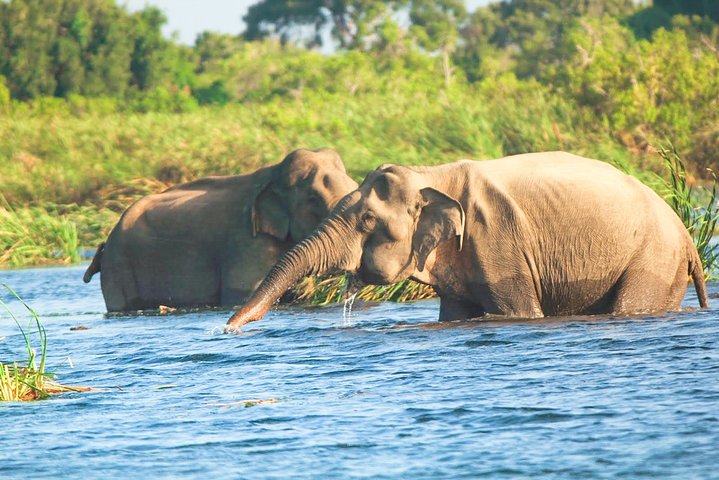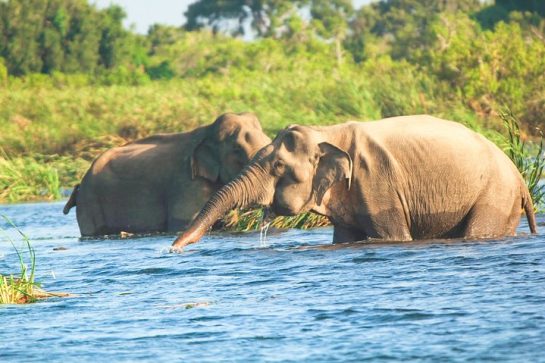Elephants are one of nature’s most awe-inspiring creations. With their remarkable intelligence, deep emotional capacity, and distinct personalities, these gentle giants captivate the curiosity of all who observe them. Highly social and led by a matriarch, elephants possess a unique language of their own. They are known to exhibit extraordinary memories, even returning to the places where their loved ones have passed – a poignant reminder of the depth of their emotional lives.
Baby elephants (or calves) experience one of the longest gestation periods in the animal kingdom, around 21.5 to 22 months, with typically one, sometimes two, calves born every 4-5 years. From the moment they enter the world, these young elephants are nurtured and protected by their herd, with touch playing a central role in their communication. Whether it’s a calf staying close to its mother or the entire herd forming a protective circle around the young in times of danger, the bond between them is undeniable.
The language of giants
Elephants communicate across vast distances using a subsonic rumble that travels through the ground, picked up by their sensitive feet and trunks. They also use a wide range of vocalizations, from powerful trumpets to low-frequency rumbles, as well as snorts, barks, grunts, and cries. These sounds serve as essential cues for their survival and bonding.
Despite their size, elephants can be surprisingly stealthy. When necessary, they can move silently through the forest, treading delicately on leaves without making a sound—a true testament to their adaptability.
The amazing elephant trunk
An elephant’s trunk is one of nature’s most extraordinary tools. It is strong enough to lift heavy logs, yet gentle enough to pick up a single delicate leaf or even a potato chip without crushing it. Scientists have found that the trunk’s dexterity is due to around 90,000 tiny muscle bundles, making it one of the most versatile appendages in the animal kingdom. The tip of the trunk, particularly, is a marvel of evolutionary adaptation, allowing these majestic creatures to interact with their environment in astonishing ways.
The threat to Asian elephants
Though Asian elephants are smaller than their African counterparts, they are the largest living land animals in Asia. Unfortunately, they are also endangered. Since 1986, Asian elephants have been listed on the IUCN Red List, with their population declining by at least 50% over the last three generations due to habitat loss, fragmentation, and poaching. While wild Asian elephants live for about 60 years, those in captivity often face shorter lifespans due to the challenges of living outside their natural environment.
A cognitive powerhouse
Elephants share a highly developed neocortex with humans, apes, and certain dolphins, enabling them to demonstrate remarkable cognitive abilities. Studies have shown that elephants are capable of tool use, mimicry, play, altruism, and even showing signs of grief. They are also known for their exceptional memory and ability to cooperate with others – a combination of traits that highlight their intelligence and emotional depth.
Sri Lanka: A sanctuary for elephants
Sri Lanka is a haven for Asian elephants, boasting one of the highest densities of elephants in Asia. The Sri Lankan elephant (Elephas maximus maximus) is one of three recognized subspecies and is native to the island. You can find these gentle giants in several national parks, including Minneriya, Udawalawe, Yala, and Kaudulla. Every year, during the dry season, Minneriya National Park plays host to the spectacular “Great Gathering,” where elephants from surrounding areas congregate in large numbers – a sight that every wildlife enthusiast should witness.
Respecting elephants: Dos and Don’ts
When encountering elephants in the wild, it’s essential to observe from a respectful distance. Never approach or feed a wild elephant, and always avoid using flash photography, which can startle and distress them. While some safari drivers may try to get you closer for a better view, remember that the welfare of these magnificent animals should always come first.
Lastly, say no to elephant rides. Supporting ethical wildlife tourism helps protect these creatures from the exploitation often seen in captivity.


Leave a Reply